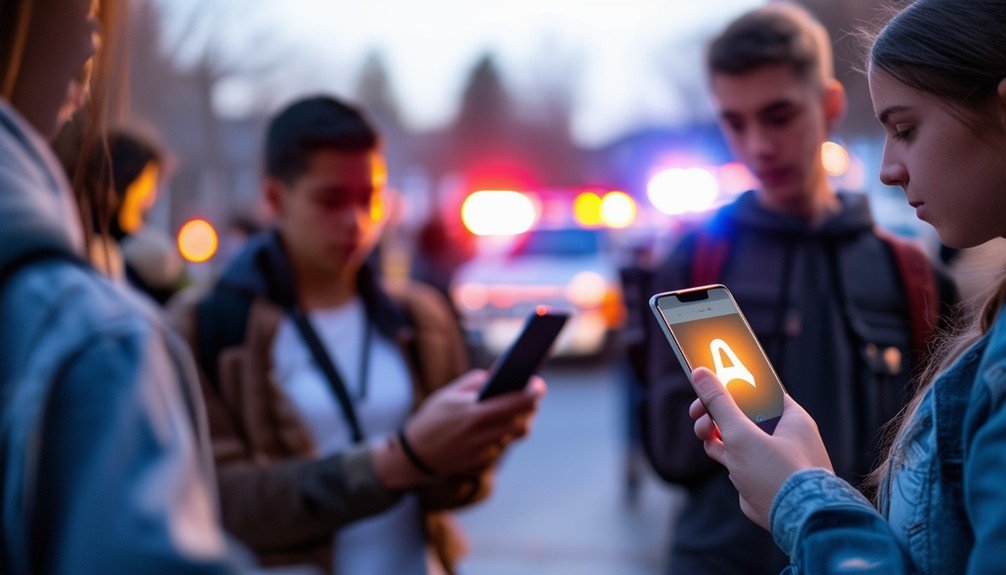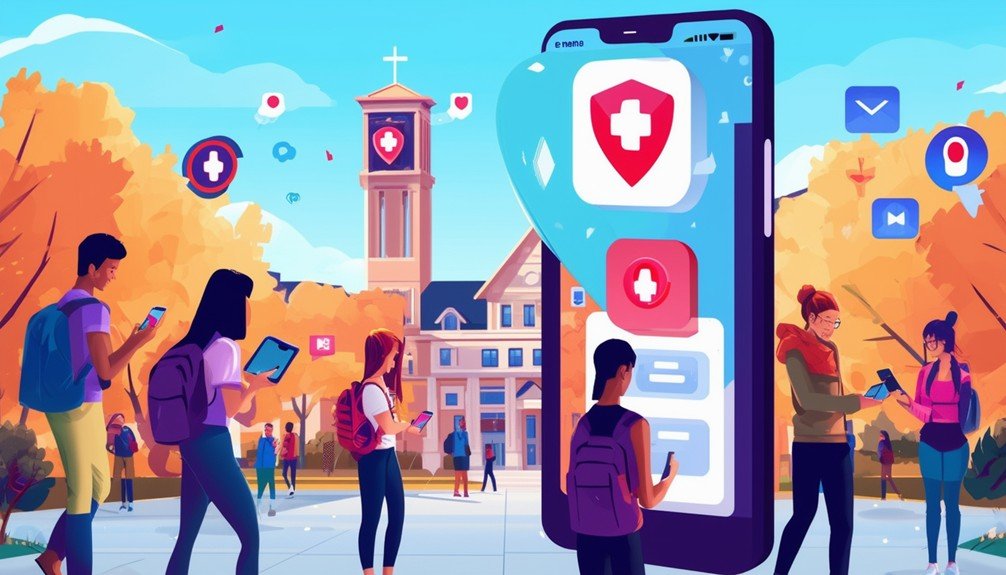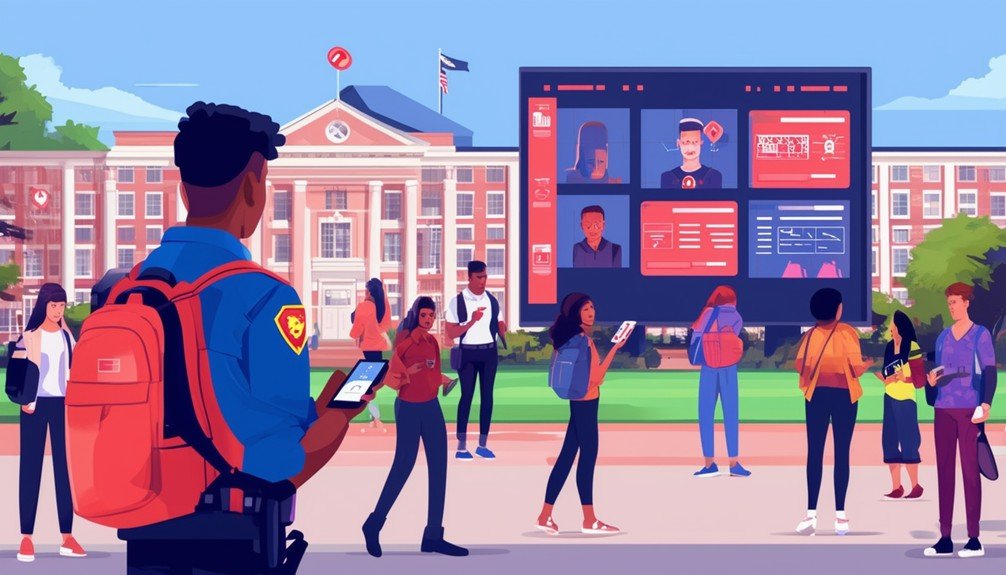Real-time emergency alerts on college campuses are essential for maintaining safety and swift communication. You’ll receive instant updates on your mobile devices, which help you make informed decisions during emergencies. Push notifications make sure you won’t miss critical information by grabbing your attention immediately. Effective systems like Zoney integrates seamlessly with existing infrastructure, providing reliable audio and visual alerts. Balancing timely alerts with mental well-being can be challenging, but practical solutions like automated notifications and geofencing technology can help. Learning about these systems and their features can greatly enhance campus safety. Explore further to understand the full scope of these lifesaving measures.
Key Takeaways
- Real-time notifications provide immediate awareness and information during emergencies for students and staff.
- Mobile push notifications ensure wide reach and instant updates on lock screens for efficient communication.
- Reliable systems like Zoney’s integrate with existing campus infrastructure, offering high-quality audio and visual alerts.
- Geofencing technology allows targeted alerts to specific campus locations, enhancing communication precision.
- Automated alerts streamline the process of notifying the campus community about critical situations swiftly.
Importance of Notification Systems

Given their ability to deliver important updates instantly, notification systems are essential for maintaining safety and communication on college campuses. These systems, a blend of software and hardware, are designed to send messages to recipients efficiently. On a campus, they play a pivotal role in disseminating emergency alerts, making sure everyone is informed about potential threats or urgent situations in real-time.
Imagine a scenario where there’s a security breach or a natural disaster. Notification systems can quickly relay emergency alerts to students, faculty, and staff, which is crucial for campus safety. These alerts can appear on mobile devices, instantly grabbing attention and prompting necessary actions. By receiving these real-time updates, you can make informed decisions about your safety.
These systems aren’t just for emergencies. They help maintain a steady flow of communication, keeping everyone updated about campus events, schedule changes, or other important notifications. The integration of notification systems into daily campus life guarantees that information is disseminated swiftly and accurately, minimizing risks and enhancing the overall safety and well-being of the campus community. Without these systems, managing campus safety and communication would be significantly more challenging.
Functionality of Push Notifications

Push notifications are essential for delivering timely messages to mobile devices, ensuring you stay informed in real-time. App publishers send these notifications directly to your lock screen, providing immediate access to critical updates. This functionality is vital for college campuses to quickly disseminate emergency alerts and keep everyone safe.
Mobile Device Messages
With the ability to deliver urgent messages directly to your lock screen, push notifications play a critical role in real-time emergency alerts on college campuses. They guarantee you receive essential information instantly, even if your phone is locked. Here’s how mobile device messages enhance campus safety:
- Immediate Awareness: Push notifications provide immediate awareness about emergencies. Whether it’s a security threat, severe weather, or campus closure, you’ll know instantly.
- Attention-Grabbing Alerts: These notifications appear prominently on your lock screen, making sure they capture your attention when it matters most. They’re designed to be hard to overlook.
- Wide Reach: Push notifications can be sent to thousands of students and staff at once, making them an efficient way to communicate across colleges and universities.
App Publisher Notifications
App publisher notifications deliver timely updates directly to your mobile device, guaranteeing you stay informed and engaged with the latest information. These push notifications are essential communication solutions, especially in the context of real-time emergency alerts on college campuses. When an emergency arises, app publisher notifications can send targeted messages that appear on your lock and phone screens, grabbing your attention immediately.
The functionality of push notifications extends beyond mere convenience; they provide vital, real-time updates that can potentially save lives. By delivering emergency alerts instantly, these notifications guarantee that you’re always in the loop, whether it’s a campus lockdown, severe weather warning, or any other urgent situation.
The usefulness of app publisher notifications isn’t limited to emergencies. They also enhance user interaction and app usage in everyday scenarios by delivering texts, sports scores, and special deals. This multifaceted approach keeps you engaged with the app, thereby fostering a habit of regular use.
Ultimately, app publisher notifications are essential for effective communication solutions on college campuses. They offer a streamlined way to disseminate targeted messages, ensuring that important information reaches you promptly and efficiently.
Impact on User Behavior

You might find that real-time emergency alerts create a compulsive need to check your phone frequently. This behavior stems from the variable rewards concept, which releases dopamine and keeps you hooked. However, this compulsivity can negatively affect your mental health, contributing to issues like depression.
Variable Rewards Concept
The variable rewards concept in notification systems compels users to compulsively check their phones, exploiting the brain’s dopamine-driven reward cycle. This mechanism can be particularly impactful in the context of emergency alerts, where timely communication is vital but the mental health implications cannot be overlooked.
When you receive a notification, your brain anticipates a reward, which may be immediate or delayed. This unpredictability keeps you hooked, leading to compulsive phone checking. While this can ensure you don’t miss critical emergency alerts, it also has detrimental effects on mental health.
Consider the following impacts:
- Constant Distraction: Frequent notifications can interrupt your focus, leading to decreased productivity.
- Increased Anxiety: The anticipation of an alert can heighten anxiety levels, impacting overall well-being.
- Mental Health Decline: Studies have linked excessive notification use to rising rates of depression and suicide.
In college campuses, where the balance between safety and mental health is delicate, understanding the variable rewards concept is crucial. By implementing more thoughtful notification systems, you can enhance emergency communication without exacerbating mental health issues. Practical adjustments, like prioritizing critical alerts and reducing non-urgent notifications, can help maintain this balance effectively.
Dopamine and Compulsivity
Dopamine released in your brain when receiving notifications drives compulsive phone checking, reinforcing addictive behaviors. Notifications are designed to exploit your brain’s craving for rhythm and pattern. Each beep or buzz delivers a dopamine hit, making it hard for you to resist checking your phone.
The variable rewards concept is pivotal here. When you receive notifications, the unpredictable nature of the rewards—likes, comments, messages—keeps your brain hooked. This continuous cycle of dopamine hits fosters compulsive behavior, making it difficult to detach from your device. It’s a calculated design, leveraging the power of instant gratification to keep you glued to your screen.
This constant need to check notifications can have serious repercussions. Studies have linked excessive use of notifications and social media platforms to increased rates of depression and even suicide. The compulsive behavior driven by dopamine is not just addictive but also harmful.
Given these impacts, the importance of managing notifications becomes clear. While real-time emergency alerts on college campuses are essential for safety, it’s vital to balance their use to prevent reinforcing addictive behaviors. Understanding the role of dopamine can help you make more informed choices about your notification settings.
Concerns and Criticisms

Concerns regarding real-time emergency alerts on college campuses highlight the potential for information overload, which could desensitize students to actual emergencies. When you receive too many notifications, it becomes easy to ignore them, even when they’re vital. This information overload can lead to several serious issues for campus communities.
- False Alarms: The more frequent the alerts, the higher the likelihood of false alarms. These inaccuracies can cause unnecessary panic and confusion.
- Mental Health: Constant alerts can contribute to heightened anxiety and stress among students. The pervasive sense of urgency can negatively impact your mental well-being.
- Desensitization: Over time, students might become numb to alerts, treating real emergencies with the same nonchalance as routine notifications.
Balancing the need for timely emergency alerts with the risk of information overload is a significant challenge. The potential for false alarms or inaccurate information only compounds the problem, making it harder for you to distinguish between genuine emergencies and less critical updates. The constant barrage of alerts can take a toll on your mental health, creating a campus environment where stress and anxiety are rampant. Administrators must carefully consider these concerns to guarantee the safety and well-being of everyone on campus.
Solutions for Campus Safety
Enhancing campus safety requires implementing reliable, integrated emergency alert systems. IP audio and visual endpoints are indispensable for broadcasting emergency alerts to students, staff, and visitors. These systems integrate seamlessly with your existing infrastructure, guaranteeing a cohesive campus security framework.
Solutions include Multi Activation Announcements, which allow you to disseminate important messages swiftly and effectively. Whether it’s a routine update or a critical alert, these announcements can be tailored to fit various scenarios, improving your mass notification system.
| Feature | Description |
|---|---|
| IP Endpoints | High-quality audio and visual alerts |
| Multi Activation Announcements | Effective for both routine and emergency communications |
| Integration | Compatible with existing campus infrastructure |
| Daily Communication | Software supports routine updates and emergency alerts |
Software isn’t just for emergencies; it’s also designed to support daily communication needs. A fine-tuned system to guarantee that your campus remains secure and well-informed. By adopting such robust solutions, you’re taking a significant step in safeguarding your campus community.
Investing in a thorough mass notification system is a practical, detail-oriented approach to campus security. Don’t compromise on safety; ensure your campus is well-equipped to handle any situation with these cutting-edge solutions.
Success Stories and Resources

Mercy College’s collaboration with Regroup showcases a successful implementation of a tailored mass notification system, enhancing campus safety through advanced features like geofencing and two-way communication. The Mercy Alert system stands out for its efficiency in delivering emergency alerts, guaranteeing the campus community is always informed and prepared.
To understand how these solutions can benefit your institution, consider the following key features:
- Geofencing Technology: This allows you to send targeted alerts to specific locations on campus, ensuring the appropriate people receive the correct information.
- Two-Way Communication: Enables witnesses and responders to communicate instantly, providing real-time updates and facilitating quicker responses.
- Automated Alerts: Streamlines the process of notifying the campus community about weather emergencies, violence, or other critical situations, reducing the risk of human error.
Solutions further complement these efforts by offering IP audio and visual endpoints that seamlessly integrate with existing infrastructure. Their Multi Activation Announcements guarantee no one misses important messages, enhancing both daily communication and emergency alerts.
For institutions in Higher Education, leveraging these resources can greatly boost campus safety, offering peace of mind and fostering a secure learning environment. Don’t overlook the importance of sophisticated, automated alerts to keep your campus community safe and informed.
Conclusion
To wrap up, you’ll acknowledge the significance of real-time emergency alerts for enhancing campus safety. You’ll appreciate push notifications for their immediacy, value their influence on user behavior, and grasp concerns and criticisms. Through the implementation of efficient solutions, you’ll strengthen campus security. Success stories and abundant resources will assist you in maximizing these systems. Embrace these tools to guarantee you’re ready, informed, and safeguarded, creating a safer environment for everyone on your campus.
Frequently Asked Questions
What Is the Best School Alert System?
You should select a school alert system that provides real-time notifications, mass communication, and customizable features like geo-targeting. Guarantee it integrates seamlessly with current infrastructure, including phones and speakers, and supports easy deployment, maintenance, and scalability.
Is There an App for Emergency Alerts?
Absolutely, there are fantastic apps out there for emergency alerts! They deliver instant notifications to your mobile device, ensuring you’re always in the loop during pivotal moments. These apps are essential for staying safe and informed.
What Are the Three Types of Emergency Alerts?
You’ll find three types of emergency alerts: text messages for quick reach, emails for detailed instructions, and sirens for immediate outdoor alerts. Using all three guarantees extensive coverage and rapid dissemination in any crisis.





